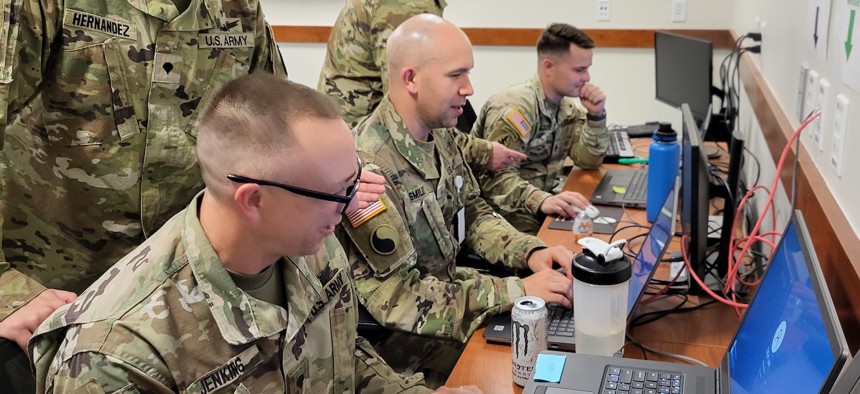
Soldiers from Army Space Support Team 22 conduct a certification at Fort Carson, Colorado, Nov. 4, 2022. U.S. Army
New Army space plan anticipates 'operator'-level space capabilities, general says
The new Army Space and Missile Defense Command leader also praised the use of Coyote anti-drone interceptors.
A new Army space initiative will see space-based capabilities pushed “down to the operator level,” the service's Space and Missile Defense Command chief Lt. Gen. Sean Gainey said last week, even as his command prepares to combat the growing threat of mixed drone and missile attacks.
In early January, the Army announced a new “vision” for Army operations in space. The plan emphasizes adapting to operations in a world where enemies use space-based assets to surveil and interfere with U.S. troops, such as jamming their communications.
The U.S. must “protect friendly forces from observation and targeting by counter-satellite communications, counter-surveillance and reconnaissance, and navigation warfare operations,” the document stated.
The document follows a push by Army Chief of Staff Gen. Randy George to help U.S. soldiers adapt to battlefields where troops can be tracked by everything from hand-held drones to satellites.
While Gainey did not mention specific space capabilities that would fall under Army purview, a key thrust of the plan is to bring space-based tools not just to brigades and battalions, but to “forward troops,” he said.
The military’s newest branch, Space Force, protects satellites and ensures the smooth running of GPS and other space-based navigation systems, among other functions.
Still, Gainey said the Army space vision is necessary because it will make it easier for the Army “to integrate capabilities into our formation down to the user level.”
The effort allows the Army to be “not reliant on an entity to provide capability,” but instead have certain functions “resident within the Army,” he said.
Gainey took command of Army Space and Missile Defense Command in January after leading the Pentagon’s anti-drone efforts as chief of the Joint Counter-small Unmanned Aircraft Systems Office (JCO).
As chief of the JCO, he presided over the push to equip both Ukraine’s forces and U.S. forces deployed abroad with the anti-drone weapons.
Such efforts have gained increasing importance amid attacks on U.S. troops in the Middle East. On Sunday, the U.S. announced the deaths of three soldiers at a base on the Jordanian border with Syria. They were killed by a one-way attack drone. Air defenders spotted the incoming drone, but did not open fire in time due to confusion about whether it was friendly, the Wall Street Journal reported.
Going forward, Gainey said he sees directed energy as a key weapon for offsetting the cost of defending bases with costly and sophisticated missiles. “We will never have enough missiles” against threats like small drones, Gainey said.
Gainey also praised Raytheon’s Coyote drone, which brings down enemy drones by flying toward them and exploding. “One of our most successful interceptors is the Coyote,” he said.
However, Gainey’s time at JCO convinced him that a single type of sensor and weapon—such as a radar and a missile—isn’t enough to deal with drone threats.
Instead, counter-drone operators need “multiple ways of detecting the threat and then multiple ways for addressing it,” he said, including with passive measures that would stop the drone but not destroy it.
Army infantry units will also need their own ability to kill drones without calling up the chain of command for support, Gainey added.
“We are now delivering counter-UAS capability all the way down to the squad level inside of the divisions,” he said. “It can’t just be an air-defense problem.”
The complex attacks launched by adversaries—including a mix of drones and missiles—now mean the U.S. must also learn to juggle between counter-drone and counter-missile weapons at the same time, he added.
“We have to be able to fuse all these capabilities together,” he said. “No longer can you just focus on counter-UAS in isolation.”
Gainey highlighted the Army’s plans to eventually field multiple Indirect Fire Protection Capability (IFPC) battalions, which will eventually be equipped with a single system designed to take out everything from drones to missiles.
The Army will field nine IFPC battalions between fiscal 2026 and fiscal 2031, according to an Army spokesperson. That’s one more than was originally scheduled, according to a 2020 Congressional Research Service report. That report identified the first, third, fifth, and 18th Airborne Corps, and 8th Army as slated rfor IFPC battalions.
